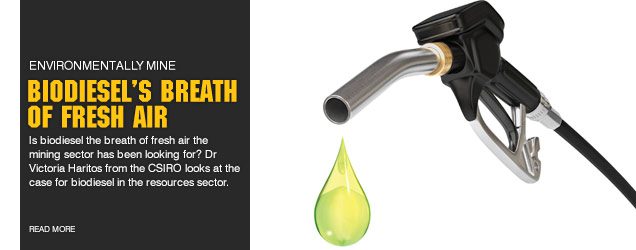Is biodiesel the breath of fresh air the mining sector has been looking for? Dr Victoria Haritos from the CSIRO looks at the case for biodiesel in the resources sector.
The 2012 classification of diesel emissions as carcinogenic to humans by the World Health Organisation (WHO) was based on evidence that human exposure to substantial concentrations of diesel particulate matter produced by burning diesel causes lung cancer and is also linked to the incidence of bladder cancer.
The WHO announcement is of particular relevance to underground mining personnel who operate diesel powered equipment within confined workplace environments. However, evidence from multiple studies conducted over the past two decades show that the use of biodiesel reduces particulate matter compared with conventional diesel. Therefore biodiesel could be considered alongside a suite of measures available for the reduction of particulate exposure in those working in confined environments.
Occupational exposure to particulate matter from diesel exhaust can be significantly higher among underground mine workers than it is for their above-ground counterparts. Although there are a range of strategies that can reduce exposure to exhaust emissions in confined conditions, they may not all be available for use in the setting or suit the equipment used.
Strategies to reduce exposure to diesel emissions include increased ventilation of the work area, fitting of after-market emissions control systems onto existing diesel powered equipment and through the use of fuels such as biodiesel which, in higher blends, can significantly reduce emissions of particulates and their associated polycyclic aromatic hydrocarbons, carbon monoxide and unburned hydrocarbons.
Compared with petroleum diesel, using biodiesel in a conventional diesel engine substantially reduces tailpipe emissions of a range of toxic and regulated substances.
A major study published by the US EPA (2002) concluded that replacing conventional diesel with a B20 blend prepared from soybean oil would reduce particulate matter (PM) emissions by 10%, carbon monoxide by 11%, and unburned hydrocarbons by 21% but raises nitrogen oxides (NOx) by about ~2%. These figures were obtained from engines that were not equipped with exhaust gas recirculation, NOx adsorbers or PM traps.
More recent studies have included engines with catalysts and other emissions reduction processes but have upheld the finding that biodiesel use results in lower PM emissions and the associated toxic soot chemicals such as polycyclic aromatic hydrocarbons. However, recent studies also show decreased PM in the exhaust of conventional diesel engines which is attributed to the lowering of sulphur in new regulated fuels, the use of new technology diesel engines and emissions reduction equipment.
In Australia biodiesel is most often blended with conventional diesel fuel in 5% (B5) or 20% (B20) mixtures although it can also be used as a neat fuel (B100) with suitable modifications and where permitted by the vehicle manufacturer.
The Alternative Fuels Data Center at the US Department of Energy describes B20 as having similar fuel consumption, horsepower, and torque to engines running on conventional diesel. 1 B20 also has a higher cetane number giving shorter ignition delay periods and therefore cleaner and more complete burn per compression cycle, and higher lubricity, than conventional diesel.
Diesel engines depend on the lubricity of the fuel to keep fuel pumps and fuel injectors from wearing prematurely. As new low sulphur, low aromatic diesel fuels have concomitantly low lubricity, biodiesel can be used to increase lubricity of these ultra low sulphur diesel fuels even at low blend levels.
Biodiesel causes far less impact than conventional diesel if spilled or released into the environment as it is readily biodegradable. The flashpoint for biodiesel is above 150°C, compared with about 52°C for conventional diesel.
No new technology or engine modification is usually required to use B20 and lower-level blends as opposed to LNG or other such products where you need to invest in new infrastructure and technology.
CASE STUDY
BLACK RIVER MINE STUDY
In 2009, the United States’ Mine Safety and Health Administration (MSHA) documented two studies of biodiesel use in Carmeuse limestone mines in the state of Kentucky. The results point to significant improvements in air quality when an underground mine site makes the switch to biodiesel.
In the Black River mine study, B35 use resulted in diesel particulate matter (DPM) reductions between 16% and 33%. Inside equipment cabs, where DPM concentrations are higher, the DPM reductions were between 40% and 55%.
In the Mayfield mine study, B50 use resulted in DPM reductions between 49% and 71%. Since the studies were done, both mines have switched to using B99.
Other mines using biodiesel, including a Barrick gold mine in Nevada, have reported similar improvements. Combining methods can further improve air quality. For example, the Stillwater palladium and platinum mine, Montana’s largest biodiesel user, uses B70 in conjunction with emission control devices.2
REFERENCES
1. http://www.afdc.energy.gov/fuels/biodiesel_blends.html
2. U.S. Department of Energy, Office of Energy Efficiency and Renewable Energy, operated by the Alliance for Sustainable Energy, LLC.














Add Comment